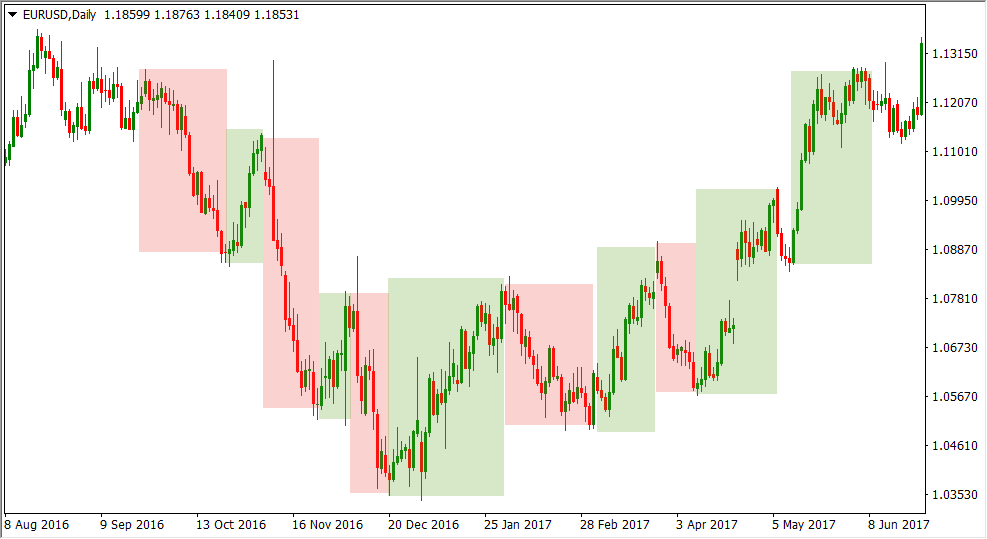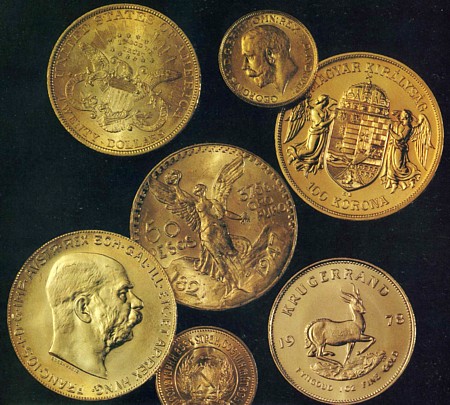

This is the daily chart of NIFTY50 during the months of January and February 2019. Since the end of January 2019, an uptrend can be seen forming in NIFTY50 levels. A Doji is very difficult to spot on the charts and therefore, finding a tri-star pattern is also extremely rare to find. This is the pattern which suggests that a trade should be initiated in the opposite direction of the existing trend. In case of a Doji Star Bearish Candlestick Pattern, one should initiate a trade on the short side.
The upper and lower trendline tend to be parallel to each other and take the shape of a rectangle, hence the name. Rectangles are continuation patterns, hence the breakout usually happens in the direction of the prevailing trend. So, if the trend before entering the consolidation is up, the breakout is likely to be on the upside. And if the trend before entering the consolidation is down, the breakout is likely to be on the downside.
Inverted hammer candlestick patterns occur when the open and close prices of securities are almost identical, but they are considerably lower than the middle price of the day. This pattern is quite rare compared to bearish reversal meaning the other candlestick patterns as it represents indecision among traders whether the market will go up or down. Inverted hammer candlestick patterns are bearish reversal patterns that indicate selling pressure.
An expanding broadening pattern has two trendlines that are diverging. Talking about the volume characteristics, volume should usually be high during the first part of the pattern when price is rising. Volume should then flatten out during the second part of the pattern, suggesting that there is an equilibrium between buyers and sellers. Finally, volume must increase during the third part of the pattern when price is declining. The rise in volume during the third part along with falling price suggests that selling interest is picking up. Finally, the breakdown must preferably be accompanied by a noticeable pickup in volume.
Is bearish reversal good?
A bearish reversal pattern is a combination of candlesticks during an uptrend. It indicates that the trend will reverse when the price falls. This is usually the case when bears replace the bulls over time. In other words, the bearish reversal pattern indicates that sellers have taken over the buyers.
Candlestick patterns are a great way to spot changes in investor sentiment and possible reversal points in the price of an asset. However, the inverted hammer candlestick chart pattern can be easily confused with other candlestick patterns such as the harami or the hanging man. After the price initially declines, it makes a greater move to the upside, returning to a level that is close to or even above the opening price.
The bullish and bearish engulfing candlestick chart patterns are one of the most common and powerful reversal indicators. So, before you start trading, understanding these patterns is a must. For a bearish engulfing pattern to form the stock opens much higher than the previous close. And the close of the bearish candle should be above the open of the bullish candle.
Advance Block: Bearish Reversal Pattern
The second candle has small trading range showing indecision formation. The first candle should be a long red candle extending the current downtrend. A candlestick that forms within the body of the previous candlestick is in a Harami position. The body of the previous day’s candlestick should completely be overshadowed by the next day’s candlestick.
The ‘Inverted Hammer’ gets formed when the price opens at a certain level and then goes much higher.. Only when an uptrend precedes the hanging guy is it considered a hanging man. This pattern helps the traders to square their buy position and enter a short position.
Talking about volume characteristics, volume tends to decline when within the triangle. However, being a bearish continuation pattern, when price is trading with the triangle, expect modest upticks in volume during declines and downticks in volume during advances. Such a development enhances the likelihood of a downside break. Preferably, the breakdown from the triangle must be accompanied by an increase in volume. However, pickup in volume at the time of breakdown in case of this pattern is not as important as pickup in volume at the time of breakout in case of an ascending triangle pattern. Meanwhile, in some cases, the pattern will break on the upside.
Bullish engulfing pattern
No worries for refund as the money remains in investor’s account. They could start with a small position and buy more once the stock begins to rise. The colour of the candle does not matter – it could be either red or green.

This pattern can also appear in both uptrends and down trends. Additionally, it is similar to the hammer candlestick pattern except that it has a long lower shadow with little or no upper shadow. The trend will be reversed in the direction of the preceding trend when an inverted hammer pattern appears, and it can be used as confirmation of a reversal in an existing trend.
share page
The second part shows an equilibrium between sellers and buyers, and provides the first hint that selling pressure is starting to ebb as price moves in a horizontal range. The third part belongs to the buyers as demand starts to gradually pick up and exceed supply. The reversal is signalled once price breaks above the high that was registered during the start of the pattern. The entire formation takes the shape of a ‘U’, and hence is called a rounding bottom. A contracting triangle is a continuation pattern that could appear during an uptrend or a downtrend.
What is bullish reversal vs bearish reversal?
The first candlestick is bullish. The second candlestick is bearish and should open above the first candlestick's high and close below its low. This pattern produces a strong reversal signal as the bearish price action completely engulfs the bullish one.
Since it is a trend reversal pattern, an abandoned baby can appear in both uptrend or downtrend. The shadow of the first candle mustn’t overlap the second candle. The star appears above or below the trend, looking abandoned, hence the moniker. Notice in the below chart how supply is coming in at higher and higher levels, while demand is coming in at a fixed level.
What is the Candlestick reversal pattern?
The prior candle, darkish cloud candle and the following confirmation candle compose the three-candle pattern. The preceding candlesticks ought to be no less than three consecutive inexperienced candles leading up the dark cloud cowl candlestick. In this, a big white candle utterly engulfs the preceding small black candle. Though it’s not essential for the white candle to engulf the shadows of the earlier black candle, it ought to engulf the whole real physique. The doji is a reversal sample that may be both bullish or bearish relying on the context of the previous candles. The candle has the identical open and shutting worth with lengthy shadows.
The former describes the open-to-close range for the traded asset, the latter, also known as a shadow, denotes the intra-day high and low. According to technical experts, the price accurately reflects all available information about the stock, meaning that it is efficient. However – past price performance does not guarantee future price performance, and a stock’s present price may have little to do with its true or intrinsic worth. As a result, technical analysts employ methods to sift through the noise and identify the greatest wagers. The Dragonfly Doji, long-legged Doji, Gravestone Doji, star Doji, and hammer Doji are some of the types of Doji in stock market.
What does bullish reversal mean?
A bullish reversal occurs when a bearish market with a downward trend begins to move in the opposite direction.
The reversal may see a sharp up move, however till the candlestick formation does not show underneath trend, the hanging man still stands firm in the negative bias. The first candle must be bullish and the second candle must be bearish . The second candle must be bigger and engulf or cover the first candle completely. The bigger the second candle, the higher will be the bearishness.
If this happens, and if volume has picked up after the breakout, then a move higher can be expected. The chart below shows a contracting triangle pattern acting as a continuation pattern. The trend prior to entering the pattern was up, and the breakout also occurred to the upside along with an increase in volume.
Trading Psychology
Receive alerts/information of your transaction/all debit and other important transactions in your Trading/ Demat Account directly from Exchange/CDSL at the end of the day. If the next candle is red and the price falls below the ‘inverted hammer’, the pattern has failed. The bearish engulfing pattern’s trade setup is exactly the same.
- This is a reliable indicator of a potential reversal to the downside.
- However – past price performance does not guarantee future price performance, and a stock’s present price may have little to do with its true or intrinsic worth.
- Now, there are few variations in the bullish engulfing pattern.
- Technical analysts interpret reversal patterns as “messages” that indicate momentum has run its course and is now traveling in the opposite direction.
- If we merge both the candles, we get a resulting candle which is a hammer candle.
- The second day opens lower than the trading of the prior day.
It is a reversal candlestick pattern that may appear in both an uptrend or a downtrend. Three Crows pattern is multiple candlestick patterns that is used for predicting reversal to the downtrend from the uptrend. This candlestick pattern are made of two candlesticks, the first being a bullish candlestick and the second one is a bearish candlestick. Hanging man is a bearish reversal candlestick pattern having a long lower shadow with a small real body.
Bearish reversal patterns should form at the end of an uptrend otherwise it will act just like a continuation pattern. Notice in each of the preceding four charts that the price projection is done from the start of the trend right until the start of the consolidation (i.e. the flag or pennant) formation. This distance is then measured from the point of break to arrive at the price objective. Notice in chart above how demand is coming in at lower and lower levels, while supply is coming in at a fixed level. Notice the deceleration in volume during the first half of the pattern. Also notice the sharp pickup in volume as price rallied from the second trough.
In the image above, let’s start with the concept of bullish engulfing . On the first day the stock opened at Rs. 100 and the second candle closed at Rs. 110. If we merge both the candles, we get a resulting candle which is a hammer candle.
What does bearish engulfing bearish reversal mean?
A Bearish Engulfing pattern is a two day bearish reversal pattern that consists of a small white candlestick with short shadows or tails followed by a large black candlestick that eclipses or ‘engulfs’ the small white one. A bearish engulfing pattern is usually seen at the end of an upward trend.


